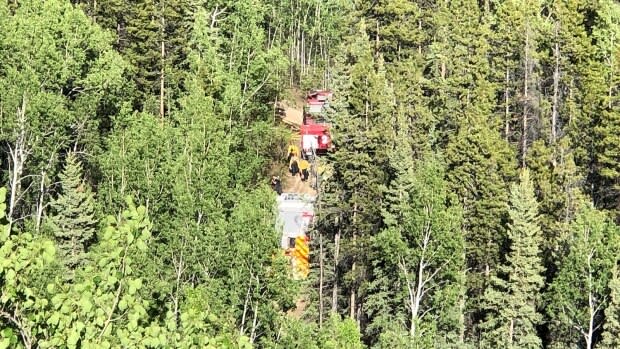Wind a factor in fatal Whitehorse plane crash, investigators find
Investigators looking into last spring's plane crash in Whitehorse that killed two Alaska men found wind conditions changed suddenly during takeoff, making it difficult for the plane to gain altitude.
The Transportation Safety Board (TSB) released its report on the May crash on Monday. It found that during takeoff the 1952 Cessna 170B accelerated and gained altitude more slowly than it should have. It never lifted more than 50 feet off the runway, investigators found.
"When the aircraft was approximately 150 feet beyond the end of the runway, it struck the ground near the perimeter road, bounced, and cleared the airport fence, beyond which is a 120-foot drop-off," the report states.
The wind, which was blowing at 28 to 37 km/h when the plane began takeoff, dropped to calm as the plane lifted off.
Jon Lee, a regional manager with the TSB, said that made it harder for the plane to generate the lift required to take flight.
"If you start your takeoff with some wind it will reduce your takeoff run," he said. "But if that wind suddenly decreases to calm or even a tail wind, you are going to be needing more runway in order to regain that airspeed that you lost."
Investigators also found the plane's wing flaps were in the wrong position for conditions at the time.

The plane stalled, recovered briefly, then stalled again and crashed into a wooded area south of the airport's runway. The wreckage caught fire, destroying instrument panels, connecting cables and much of the engine. That made it more difficult for the TSB to investigate, Lee said.
"A lot of the accessories and components were burned away or extremely heat-damaged, such that if there was any kind of pre-impact issue, any of those marks or indicators would be melted or burned away," he said.
Aborted takeoff in Minnesota
Charles Benson, 56, of Palmer, Alaska, and Jeffrey Babcock, 58, of Wasilla, Alaska, died of injuries they sustained in the crash. The plane was registered in Benson's name. Both men were experienced pilots.
The two men had purchased the plane in Minnesota and were flying it back to Alaska when the crash took place. Records show the plane's maintenance history met regulations, the report stated.
Investigators learned that while departing the airport in Minneapolis the plane encountered "controllability" issues and the pilots aborted takeoff. Investigators could not "determine the nature of the controllability issues," the report stated.
After the takeoff attempt from Minneapolis, Benson and Babcock unloaded some cargo from the plane and made arrangements to have the cargo shipped to Alaska.
They took off from Minneapolis the next day, headed northwest.

